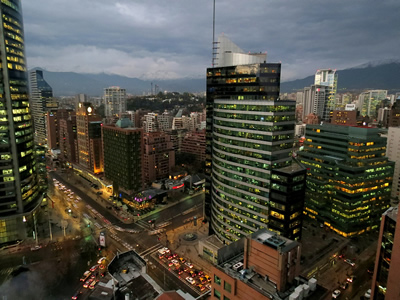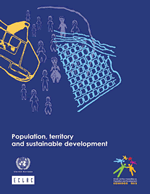Urbanization Represents Opportunities and Challenges in Terms of
Progressing towards Sustainable Development

Photo: Miguel Angel Labarca, Flickr
Latin America is the most urbanized region in the developing world. Two thirds of the Latin American population live in cities of 20,000 or more inhabitants, and almost 80% live in urban areas.
Projections suggest that the region's high urban percentages will continue to rise, albeit at slower rates. This was the find of the ECLAC document Population, territory and sustainable development, which was recently presented at the meeting of the ECLAC Ad Hoc Committee on Population and Development, held in Quito, Ecuador.
According to the document, one simple fact amply illustrates the demographic importance of large cities (with one million or more inhabitants) in Latin America and the Caribbean: there has been an increase from eight such cities in 1950 to 56 in 2010, and one in three people in the region live there.
According to the ECLAC Executive Secretary, Alicia Bárcena, in her opening speech to the Committee meeting in Quito “Territory matters... a lot. We have to be prepared for an increasingly urbanized future”.
The ECLAC document states that, while urbanization is an opportunity for sustainable development, its rapid spread throughout the region is giving rise to methodological, theoretical and policy controversies, as well as having complex effects on territories.
While there is much evidence to support the positive visions of urbanization, there remain problems, difficulties and challenges arising from the fast growth and intensity of urbanization.
In the ECLAC document, “urban deficits” are said to include poverty and housing informality and insecurity (slums or shanty towns), lack of coverage of basic services and poor service quality, public transport deficiencies, private transport problems and scarcity of community facilities and public spaces.
The study states that what happens in large urban areas is crucial for sustainable development, and provides several encouraging examples in terms of indicators, policies aimed at tackling the above-mentioned deficits and improved planning to make urban areas more functional and welcoming for their inhabitants.
From the perspective of public policies in general, one key implication of the advance of urbanization is that social demands and requirements will not only be concentrated in cities, but that they will become more urban in nature.
ECLAC experts have identified two challenges in this regard. One is the lack of metropolitan governments with political legitimacy, solvent finances and technical and administrative capacity. The second is the limited experience, weak political will and lack of instruments to take action on pressing matters such as public safety, property speculation, traffic congestion and residential segregation.
From among the policy suggestions made to date, the document recommends reducing inequality in basic municipal services by strengthening the finances of local governments with fewer resources, as well as facilitating access to urban land for the poor (to discourage them from moving to peripheral areas with limited facilities and accessibility), promoting participation and encouraging families that require housing to join forces, and taking actions in other areas of segregation including schooling (which involves restoring the social diversity and improving the quality of public schools).
As for the environment, the treatment and recycling of waste must be a priority if cities are to avoid turning into vectors of environmental damage by transferring their waste to other ecosystems. The report concludes: “But this is not enough. Ultimately, urban production and consumption patterns determine much of the environmental impact of cities, so households and individuals alike should build the idea of sustainability and environmental stewardship into their behaviour”.
LATIN AMERICA AND THE CARIBBEAN: CONCENTRATION OF THE POPULATION
IN LARGE CITIES,
1950-2010
|
|
Cities of 1 million or more inhabitants |
||||||
|
|
1950 |
1960 |
1970 |
1980 |
1990 |
2000 |
2010 |
|
Number of cities |
8 |
11 |
17 |
26 |
38 |
48 |
56 |
|
Population (in thousands of people) |
17 981 |
30 070 |
53 965 |
86 003 |
119 737 |
156 623 |
186 185 |
|
Percentage of the total population |
11.1 |
14.1 |
19.4 |
24.3 |
27.6 |
30.6 |
32.0 |
|
Percentage of the urban population |
26.8 |
28.7 |
33.8 |
37.1 |
38.9 |
40.5 |
40.2 |
Source: Latin American and Caribbean Demographic Centre (CELADE) - Population Division of ECLAC, on the basis of United Nations, World Population Prospects: The 2010 Revision and World Urbanization Prospects: The 2007 Revision [online] https://esa.un.org/unup
More
HEADLINES
“Social progress is not limited to social policies”
| The number of large cities (with one million or more inhabitants) in Latin America and the Caribbean has increased from eight in 1950 to 56 in 2010, and one in three people in the region live there. | |
|
|
|
|
While there is much evidence to support the positive visions of urbanization, there remain problems, difficulties and challenges arising from the fast growth and intensity of urbanization. |
|
